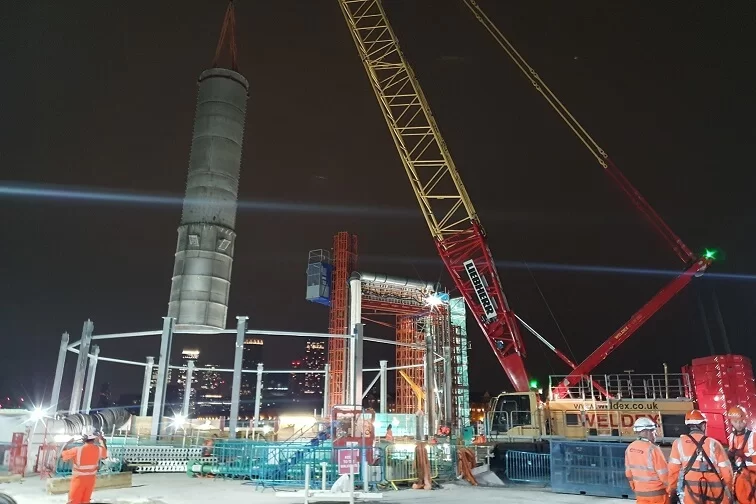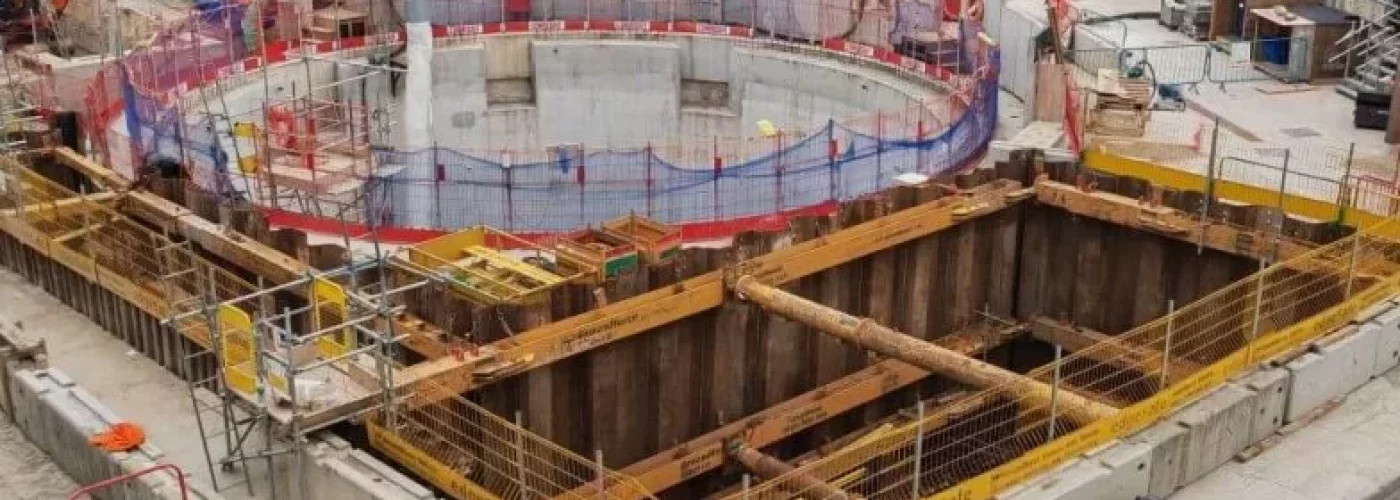Vinci Construction Grands Projects and Bachy Soletanche JV, the Costain, demanded mining support to install an air treatment unit (ATU) at Tideway’s Deptford Church Street site in Lewisham. The ATU will control and treat air exhausted from London’s 25km long “super sewer” tunnel.
The Costain has installed the ATU alongside a 60m deep, 16m diameter shaft that is said to move effluent from street level to the main sewer tunnel downward.
In turn, Groundforce Shorco supplied a sheet piling and structural support solution for the ATU excavation. It is located in a confined area adjacent to the main shaft and includes three separate sections.
The section engineer, Freddie Gorman, pointed out: “When the sewer is operating, air will build up inside and needs to be vented,”
“We can’t just let it come straight out; it needs to be filtered. When the shaft is completed, it will be capped and any air trapped inside will be fed through the ATU, where it’s treated. It then goes into a ventilation chamber before being vented out into the atmosphere.”
For supporting the excavation, Groundforce supplied KD6 sheets and Larssen sheet piles with its Mechshore, Maxi and Mega Bracing frames. Three levels of the frame with the larger capacity Mega Brace frames located at the bottom to support the higher loads were installed.
Arpad Nagy, Groundforce area manager, illustrated that the temporary works design was complicated since the three sections of the excavation, each a distinct size and depth, were built back-to-back.
Nagy expressed: “The frames work with and against each other and are interdependent. That means we couldn’t make any changes to one frame without affecting all of the others.”

In addition, the steel sheets lining the excavation act as the outer skin of the formwork necessitates to pour the reinforced concrete walls of the ATU chamber.
He continued: “The original plan was to use formwork to construct the ATU walls, but by pouring the concrete against the sheet piles the project cost has been reduced.”
The excavation’s complexity, merged with varying ground levels and the proximity of the main shaft, meant the temporary works design process was tough.
Nagy claimed: “The whole evolution of the temporary works design took around seven months and went through eight different versions.” The first design meeting was in April 2021, and the first delivery of equipment to the Tideway site was not until December 2021.
Another obstacle for the site team was the ground conditions on the site, which were extremely hard and stony. This made it challenging to install the steel sheet piles just with the excavator-mounted vibrating hammer. Therefore, a pre-augering method had to be acquired. Also, several sheet piles still remain to be installed.
However, the proximity of the current shaft resulted in additional problems.
Ross Hope, a senior engineer, explained: “We were tasked with designing a system to allow the removal of the sheets which were blocking the connection, as well as providing enough clearance to allow the concrete walls to be fully cast. We came up with using a trapezoidal frame in order to transfer loads to the existing capping beam, followed by a secondary temporary frame propping off the top of the capping beam in order to allow the removal of the frames below.”
The task has now advanced onto a second phase which was the excavation to obtain a long culvert that channels the filtered air from the ATU to the ventilation chamber.
Nagy clarified: “This excavation will be just as complicated, but we’ve learned a few things in phase one, so I’m sure we can provide a suitable solution.”
The ATU is located near the historic St Paul’s Church in Deptford and is an element of the £4.3bn Thames Tideway Tunnel project. It is said to create a combined sewer, running mainly beneath the tidal section of the River Thames across London, to capture, store and convey 95% of the raw sewage and rainwater which presently overflows into the Thames.
Building, Design & Construction Magazine | The Choice of Industry Professionals





